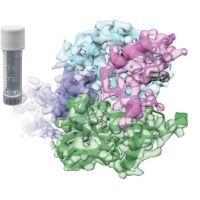Specification
| Description | Recombinant protein from the full-length sequence of Homo sapiens phospholipase A and acyltransferase 3 (PLAAT3), transcript variant 1 (NM_007069). |
| Organism | Homo sapiens (Human) |
| Expression Host | Human Cells |
| Tag Info | His or DYKDDDDK. Please contact us if you need further information or require specific designed tag. |
| Purity | Greater than 90% by SDS-PAGE gel |
| Uniprot ID | P53816 |
| Entry Name | PLAT3_HUMAN |
| Gene Names | PLAAT3 HRASLS3 HREV107 PLA2G16 |
| Alternative Gene Names | HRASLS3 HREV107 PLA2G16 |
| Alternative Protein Names | Phospholipase A and acyltransferase 3 (EC 2.3.1.-) (EC 3.1.1.32) (EC 3.1.1.4) (Adipose-specific phospholipase A2) (AdPLA) (Group XVI phospholipase A1/A2) (H-rev 107 protein homolog) (H-REV107) (HREV107-1) (HRAS-like suppressor 1) (HRAS-like suppressor 3) (HRSL3) (HREV107-3) (Renal carcinoma antigen NY-REN-65) |
| Application | Antigens, Western, ELISA and other in vitro binding or in vivo functional assays, and protein-protein interaction studies; For research & development use only! |
| Buffer | Purified protein formulated in a sterile solution of PBS buffer, pH7.2, without any preservatives |
| Endotoxin | Endotoxin level is < 0.1 ng/µg of protein (<1EU /µg) |
| Length | 162 |
| Molecular Weight(Da) | 17937 |
| Protein Sequence | (The sequence of expressed protein may have some variation from the sequence shown below. Please contact us for the exact sequence.) MRAPIPEPKPGDLIEIFRPFYRHWAIYVGDGYVVHLAPPSEVAGAGAASVMSALTDKAIVKKELLYDVAGSDKYQVNNKHDDKYSPLPCSKIIQRAEELVGQEVLYKLTSENCEHFVNELRYGVARSDQVRDVIIAASVAGMGLAAMSLIGVMFSRNKRQKQ |
Background
| Function | FUNCTION: Exhibits both phospholipase A1/2 and acyltransferase activities (PubMed:19615464, PubMed:19047760, PubMed:22825852, PubMed:22605381, PubMed:26503625). Shows phospholipase A1 (PLA1) and A2 (PLA2) activity, catalyzing the calcium-independent release of fatty acids from the sn-1 or sn-2 position of glycerophospholipids (PubMed:19615464, PubMed:19047760, PubMed:22825852, PubMed:22605381, PubMed:22923616). For most substrates, PLA1 activity is much higher than PLA2 activity (PubMed:19615464). Shows O-acyltransferase activity,catalyzing the transfer of a fatty acyl group from glycerophospholipid to the hydroxyl group of lysophospholipid (PubMed:19615464). Shows N-acyltransferase activity, catalyzing the calcium-independent transfer of a fatty acyl group at the sn-1 position of phosphatidylcholine (PC) and other glycerophospholipids to the primary amine of phosphatidylethanolamine (PE), forming N-acylphosphatidylethanolamine (NAPE), which serves as precursor for N-acylethanolamines (NAEs) (PubMed:19615464, PubMed:19047760, PubMed:22825852, PubMed:22605381). Exhibits high N-acyltransferase activity and low phospholipase A1/2 activity (PubMed:22825852). Required for complete organelle rupture and degradation that occur during eye lens terminal differentiation, when fiber cells that compose the lens degrade all membrane-bound organelles in order to provide lens with transparency to allow the passage of light. Organelle membrane degradation is probably catalyzed by the phospholipase activity (By similarity). {ECO:0000250|UniProtKB:Q8R3U1, ECO:0000269|PubMed:19047760, ECO:0000269|PubMed:19615464, ECO:0000269|PubMed:22605381, ECO:0000269|PubMed:22825852, ECO:0000269|PubMed:22923616, ECO:0000303|PubMed:26503625}.; FUNCTION: (Microbial infection) Acts as a host factor for picornaviruses: required during early infection to promote viral genome release into the cytoplasm (PubMed:28077878). May act as a cellular sensor of membrane damage at sites of virus entry, which relocalizes to sites of membrane rupture upon virus unfection (PubMed:28077878). Facilitates safe passage of the RNA away from LGALS8, enabling viral genome translation by host ribosome (PubMed:28077878). May also be involved in initiating pore formation, increasing pore size or in maintaining pores for genome delivery (PubMed:28077878). The lipid-modifying enzyme activity is required for this process (PubMed:28077878). {ECO:0000269|PubMed:28077878}. |
| Pathway | |
| Protein Families | H-rev107 family |
| Tissue Specificity | Widely expressed. low expression, if any, in hematopoietic cells and thymus. In testis, confined to round spermatids. Expressed in normal ovarian epithelial cells. Down-regulated in some ovarian carcinomas and testicular germ cell tumors. Highly expressed in white adipose tissue (PubMed:19136964). {ECO:0000269|PubMed:11526504, ECO:0000269|PubMed:11973642, ECO:0000269|PubMed:19136964, ECO:0000269|PubMed:19615464, ECO:0000269|PubMed:9771974}. |
QC Data
| Note | Please contact us for QC Data |
| Product Image (Reference Only) |  |

